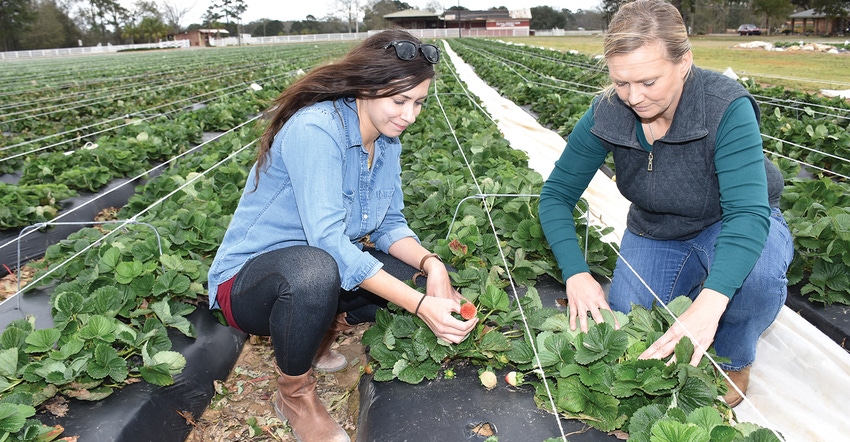January 31, 2017

Despite floods, wind and freezing temperatures, some Louisiana strawberry producers are optimistic about the season.
LSU AgCenter agent Whitney Wallace in Tangipahoa Parish said some growers saw extensive damage from the recent freeze, while others saw minor crop loss.
“Some of our growers here in Tangipahoa did sustain some damage with the freeze, but overall it’s not too bad,” she said. “Some of the worst damage occurs when the blooms that are on the plants are burnt from the cold weather.”
Growers commonly prepare for cold weather by using cloth row covers to retain heat when the temperature drops below freezing.
Natalie Jones, farm manager of Faust Farms in Amite, La., has experienced the full gamut of destructive weather this season.
“A combination of tornado-force winds that damaged my packing shed, heavy rains and frigid temperatures have created some unique challenges for us this season,” Jones said.
A third-generation farmer, Jones said her grandfather started the farm in 1985 with 5 acres of cabbage in Tickfaw.
“From there, we moved to Amite, where we now have a total of 60 acres,” she said. “We raise 10 acres of strawberries at this location and on our property in Independence.”
Jones said she sustained some minor strawberry damage, mainly around the edges of her fields, but expects to be back in the fields picking berries by the end of January.
“We do have some berries and blooms that were burnt, and they have to be discarded. But the damage was not that extensive,” Jones said.
Start to finish
Strawberry farmers start planting their crop in late September or early October and finish harvesting by mid- to late May.
Wallace is currently evaluating the amount of damage other producers in the parish have sustained because of the recent weather conditions.
“In the past, strawberry producers used sprinklers to coat the plants in freezing temperatures,” Wallace said. “This was the norm years ago because once the water freezes around the plants, the temperatures will not drop below 32 degrees.”
Today, most growers use cloth covers to keep the heat around the plants to avoid extensive damage to the crop, Wallace said.
“With the recent freezing event, we had to double cover some of our fields, which is responsible for keeping much of the crop from damage,” Jones said.
Growers leave the covers on the plants until they know the low temperatures will be in the lower 40s, she said.
She didn’t sustain damage from the multiple floods that occurred in the area this past spring and fall.
“We did, however, receive considerable wind damage a few weeks ago that took the back side off of our packing shed,” Jones said.
Jones is one of the first strawberry producers to become certified under the Good Agricultural Practices (GAP) program.
“What this means is strawberries from Natalie’s farm can be easily identified, and the program reduces the risk of contamination,” Wallace said.
The goal of the GAP certification is to minimize microbial food safety hazards for fresh fruits and vegetables, she said.
“What this means is I can go to any grocery store within the state and present my credentials that tell about our safety regulations,” Jones said.
The number of strawberry farmers in the state has decreased from about 200 in 2005 to just over 80 now. According to the 2015 Louisiana Ag Summary, the gross farm value of the strawberry industry was just over $15 million per year.
Whitney Wallace can be reached at (985) 748-9381 or [email protected].
About the Author(s)
You May Also Like




